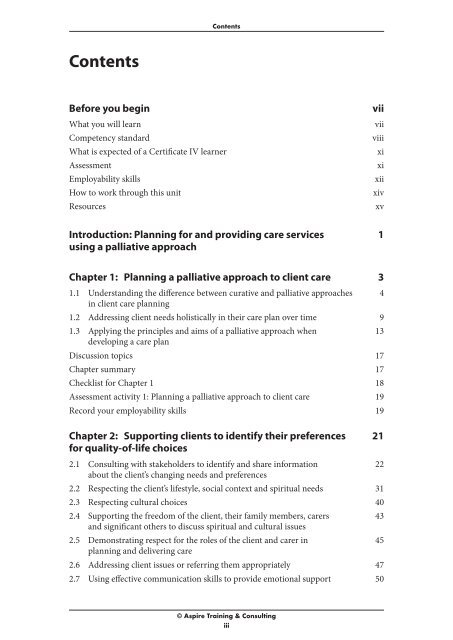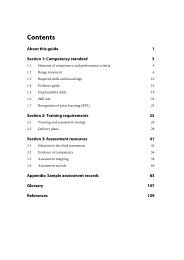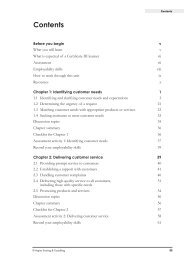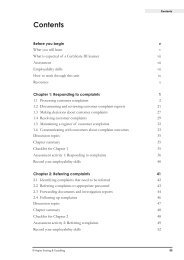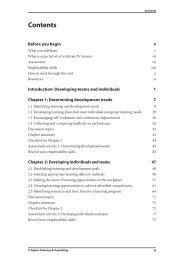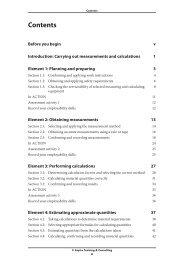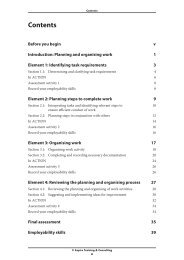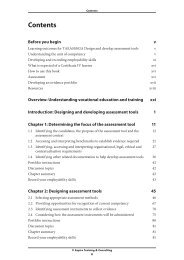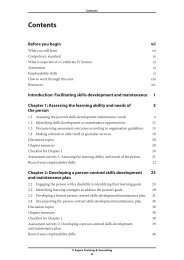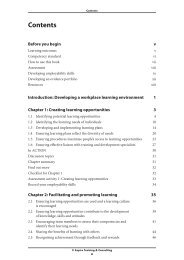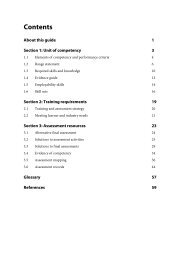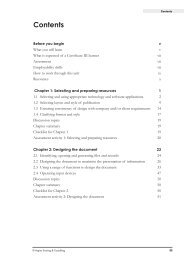CHCPA402B Plan for and provide care services using a palliative ...
CHCPA402B Plan for and provide care services using a palliative ...
CHCPA402B Plan for and provide care services using a palliative ...
You also want an ePaper? Increase the reach of your titles
YUMPU automatically turns print PDFs into web optimized ePapers that Google loves.
ContentsContentsBe<strong>for</strong>e you beginWhat you will learnCompetency st<strong>and</strong>ardWhat is expected of a Certificate IV learnerAssessment Employability skillsHow to work through this unitResourcesviiviiviiixixixiixivxvIntroduction: <strong>Plan</strong>ning <strong>for</strong> <strong>and</strong> providing <strong>care</strong> <strong>services</strong> 1<strong>using</strong> a <strong>palliative</strong> approachChapter 1: <strong>Plan</strong>ning a <strong>palliative</strong> approach to client <strong>care</strong> 31.1 Underst<strong>and</strong>ing the difference between curative <strong>and</strong> <strong>palliative</strong> approaches 4in client <strong>care</strong> planning1.2 Addressing client needs holistically in their <strong>care</strong> plan over time 91.3 Applying the principles <strong>and</strong> aims of a <strong>palliative</strong> approach when 13developing a <strong>care</strong> planDiscussion topics 17Chapter summary 17Checklist <strong>for</strong> Chapter 1 18Assessment activity 1: <strong>Plan</strong>ning a <strong>palliative</strong> approach to client <strong>care</strong> 19Record your employability skills 19Chapter 2: Supporting clients to identify their preferences 21<strong>for</strong> quality-of-life choices2.1 Consulting with stakeholders to identify <strong>and</strong> share in<strong>for</strong>mation 22about the client’s changing needs <strong>and</strong> preferences2.2 Respecting the client’s lifestyle, social context <strong>and</strong> spiritual needs 312.3 Respecting cultural choices 402.4 Supporting the freedom of the client, their family members, <strong>care</strong>rs 43<strong>and</strong> significant others to discuss spiritual <strong>and</strong> cultural issues2.5 Demonstrating respect <strong>for</strong> the roles of the client <strong>and</strong> <strong>care</strong>r in 45planning <strong>and</strong> delivering <strong>care</strong>2.6 Addressing client issues or referring them appropriately 472.7 Using effective communication skills to <strong>provide</strong> emotional support 50© Aspire Training & Consultingiii
Be<strong>for</strong>e you beginAssessment activity 4: Contributing to the development <strong>and</strong> implementation 98of end-of-life <strong>care</strong> strategiesRecord your employability skills 98Chapter 5: Taking action to alleviate pain <strong>and</strong> other 99end-of-life symptoms5.1 Collaborating with others to plan <strong>and</strong> document strategies to 100promote com<strong>for</strong>t5.2 Assessing <strong>and</strong> reporting the client’s need <strong>for</strong> pain relief <strong>and</strong> other 105symptom relief5.3 Providing pain relief in line with relevant legislation, organisational 112policies <strong>and</strong> the <strong>care</strong> plan5.4 Providing in<strong>for</strong>mation about the use of pain-relieving medication 114<strong>and</strong> other treatments to staff, clients <strong>and</strong> their family members5.5 Observing, reporting <strong>and</strong> documenting the effectiveness of 117interventions <strong>for</strong> symptom relief5.6 Communicating <strong>and</strong> documenting the ineffectiveness of interventions 119Discussion topics 120Chapter summary 120Checklist <strong>for</strong> Chapter 5 120Assessment activity 5: Taking action to alleviate pain <strong>and</strong> other 121end-of-life symptomsRecord your employability skills 124Chapter 6: Identifying <strong>and</strong> managing emotional 125responses in yourself <strong>and</strong> others6.1 Identifying <strong>and</strong> reflecting on your own emotional responses to 126death <strong>and</strong> dying6.2 Reflecting on the impact of your responses on yourself <strong>and</strong> others 1286.3 In<strong>for</strong>ming others about available support systems 1316.4 Following organisational policies <strong>and</strong> procedures in relation to 133emotional welfare6.5 Assisting colleagues to debrief <strong>and</strong> discuss bereavement <strong>care</strong> 1366.6 Identifying other strategies <strong>and</strong> resources available <strong>for</strong> debriefing 1396.7 Evaluating the effectiveness of emotional response strategies 141Discussion topics 143Chapter summary 143Checklist <strong>for</strong> Chapter 6 144Assessment activity 6: Identifying <strong>and</strong> managing emotional responses 145in yourself <strong>and</strong> othersRecord your employability skills 146© Aspire Training & Consultingv
<strong>CHCPA402B</strong> <strong>Plan</strong> <strong>for</strong> <strong>and</strong> <strong>provide</strong> <strong>care</strong> <strong>services</strong> <strong>using</strong> a <strong>palliative</strong> approachFinal assessment: <strong>CHCPA402B</strong> <strong>Plan</strong> <strong>for</strong> <strong>and</strong> <strong>provide</strong> 147<strong>care</strong> <strong>services</strong> <strong>using</strong> a <strong>palliative</strong> approachEmployability skills 153Glossary 155© Aspire Training & Consultingvi
Be<strong>for</strong>e you beginBe<strong>for</strong>e you beginWhat you will learnThis unit is based on <strong>CHCPA402B</strong> <strong>Plan</strong> <strong>for</strong> <strong>and</strong> <strong>provide</strong> <strong>care</strong> <strong>services</strong> <strong>using</strong> a <strong>palliative</strong>approach from the CHC08 Community Services Training Package.Knowledge <strong>and</strong> skills requiredThe following is a list of the knowledge <strong>and</strong> skills required of a worker in contributingto the development, implementation, evaluation <strong>and</strong> communication of a <strong>care</strong> plan <strong>for</strong>clients with life-limiting illness <strong>and</strong>/or normal ageing process in a team environment<strong>using</strong> a <strong>palliative</strong> approach.KnowledgeLearners should underst<strong>and</strong>:• relevant policies, protocols <strong>and</strong> practices of the organisation in relation to theprovision of both a <strong>palliative</strong> approach <strong>and</strong> <strong>palliative</strong> <strong>care</strong>• how to identify <strong>and</strong> access relevant resources• the <strong>palliative</strong> approach to <strong>care</strong> of clients <strong>and</strong> their family• diverse cultural aspects• the complexity of <strong>care</strong>rs’ needs <strong>and</strong> potential issues• their own role <strong>and</strong> responsibilities, <strong>and</strong> those of other team members involved indelivering a <strong>palliative</strong> approach <strong>and</strong> <strong>care</strong>• the impact of loss <strong>and</strong> grief on clients, <strong>care</strong>rs <strong>and</strong> workers• state <strong>and</strong> territory legislation on advanced <strong>care</strong> planning <strong>and</strong> advanced <strong>care</strong>directives• ethical <strong>and</strong> legal issues related to a <strong>palliative</strong> <strong>care</strong> approach• basic in<strong>for</strong>mation about the use of pain relieving medication <strong>for</strong> staff, clients <strong>and</strong>their family <strong>and</strong> within level of responsibility• hydration <strong>and</strong> nutrition requirements during a <strong>palliative</strong> approach <strong>and</strong> at end of life• the various signs of imminent death/deterioration.SkillsLearners should have the ability to:• communicate effectively with clients, their families, <strong>care</strong>rs <strong>and</strong> other team members<strong>using</strong> effective listening, sensitive clarification <strong>and</strong> questioning, recognition ofnonverbal cues, <strong>and</strong> provision of in<strong>for</strong>mation within level of responsibility• share knowledge <strong>and</strong> in<strong>for</strong>mation with other team members regarding the <strong>palliative</strong>approach• contribute to the provision of an environment that supports clients <strong>and</strong> theirfamilies <strong>and</strong> ensures other staff members are able to <strong>provide</strong> a <strong>palliative</strong> approachto <strong>palliative</strong> <strong>care</strong>© Aspire Training & Consultingvii
<strong>CHCPA402B</strong> <strong>Plan</strong> <strong>for</strong> <strong>and</strong> <strong>provide</strong> <strong>care</strong> <strong>services</strong> <strong>using</strong> a <strong>palliative</strong> approachThe following example describes a client’s lifestyle, social <strong>and</strong> spiritual needs.ExampleAn elderly woman, Rose, requires abdominal surgery. Following surgery she is unable to beweaned from the ventilator. She has a history of severe cardiac disease <strong>and</strong> recovery canonly be achieved by having a heart transplant. Her elderly husb<strong>and</strong> has Alzheimer’s disease,her daughter has an intellectual h<strong>and</strong>icap <strong>and</strong> her son lives a considerable distance from thehospital.The worker speaks to Rose about her feelings, beliefs, values <strong>and</strong> goals in life. Rose clearlyunderst<strong>and</strong>s the condition of her heart <strong>and</strong> is clear about her wishes if her heart stops: she doesnot want to be resuscitated. As the conversation continues Rose explains what is important toher at this time. She comes up with the following list, which is documented in her <strong>care</strong> plan. Shewants to:• always be kept clean <strong>and</strong> <strong>for</strong> a little bit of make-up to be applied• be dressed in her favourite casual clothes• have pictures in her room of her family <strong>and</strong> dog• have the Bible <strong>and</strong> rosary beads her husb<strong>and</strong> gave her be<strong>for</strong>e he became ill, <strong>and</strong> have herfavourite Catholic priest visit her weekly• be able to speak to her family on a regular basis <strong>and</strong> there<strong>for</strong>e asks <strong>for</strong> a phone to beplaced in her room• have relaxing music to help her sleep at night• keep on the ventilator• have pain medications when she requires them• have an enduring power of attorney (medical treatment) appointed so her husb<strong>and</strong> is notbothered.A conference is called to discuss the impact of Rose’s wishes <strong>and</strong> to update her <strong>care</strong> plan.Documenting observationsThe Guidelines <strong>for</strong> a <strong>palliative</strong> approach in residential aged <strong>care</strong> recommend that all stepsregarding a client’s preferences about their <strong>care</strong> or treatment must be documented. Thesepreferences should be regularly assessed to ensure they remain current. For example,a client may no longer want to participate in a social activity or decide that they dowant to undergo a specific treatment after all, even though it contravenes their religiousbeliefs.Care plans should be reviewed in accordance with the organisation’s policy or when:• the client experiences a change in their health condition; <strong>for</strong> example, an acuteepisode of illness or a change to their chronic condition• the family <strong>and</strong>/or <strong>care</strong>rs request a case conference to review the client’s <strong>care</strong> plan• there is a change in the client’s situation, such as the death of a spouse• the client is transferred either into or from the <strong>palliative</strong> <strong>care</strong> environment.© Aspire Training & Consulting38
<strong>CHCPA402B</strong> <strong>Plan</strong> <strong>for</strong> <strong>and</strong> <strong>provide</strong> <strong>care</strong> <strong>services</strong> <strong>using</strong> a <strong>palliative</strong> approachTips••••••••••Speak clearly, use plain English <strong>and</strong> avoid <strong>using</strong> jargon.Tailor the in<strong>for</strong>mation you are communicating to the individual needs of the client, theirfamily members <strong>and</strong> <strong>care</strong>rs. Pace in<strong>for</strong>mation to client circumstances. Seek to underst<strong>and</strong>,not to convince.Listen <strong>care</strong>fully so you know what someone is saying; never interrupt someone be<strong>for</strong>e theyfinish speaking. Do not anticipate what the client might say; listen instead.Ask questions to clarify what someone is saying if you don’t underst<strong>and</strong> them; encourageothers to do the same. Open questions encourage conversation; <strong>for</strong> example, ‘How doesthat make you feel?’Repeating what a client has said lets them know you underst<strong>and</strong> them <strong>and</strong> that youacknowledge their thoughts. If you are unsure whether you underst<strong>and</strong> the client, askthem to clarify their thoughts <strong>for</strong> you.Be prepared to repeat explanations, check people’s underst<strong>and</strong>ing of what has beendiscussed <strong>and</strong> make sure the in<strong>for</strong>mation <strong>provide</strong>d meets the client’s, family’s <strong>and</strong> <strong>care</strong>rs’needs.Show empathy <strong>and</strong> sensitivity; never try to laugh off anything that is said.Use body language to convey appropriate feelings, such as nodding your head inunderst<strong>and</strong>ing, leaning <strong>for</strong>wards, maintaining eye contact <strong>and</strong> touching the person lightly(if this is appropriate).Recognise nonverbal cues from others, such as frowning, shaking their head or closingtheir eyes.Don’t give advice unless it is asked <strong>for</strong>. If you do give advice, offer it with humility.Practice task 151. Re-read the list of tips <strong>for</strong> communicating <strong>and</strong> tick those you feel confident you can do. Puta mark against the ones you feel you need to improve.2. How can you plan to work on those communication skills you need to improve?Using effective communication strategiesEfficient communication with clients <strong>and</strong> other members of the <strong>palliative</strong> <strong>care</strong> teamis essential. The <strong>palliative</strong> <strong>care</strong> team should conduct regular meetings to maintainawareness of the client’s current situation <strong>and</strong> the <strong>care</strong> being <strong>provide</strong>d. These meetingsshould also involve the client, their family <strong>and</strong> <strong>care</strong>rs, where possible, allow them toreceive current in<strong>for</strong>mation about the client’s status <strong>and</strong> give them an opportunity tovoice their concerns.The following communication strategies may help you develop effective communicationskills.• Ask the client who they want involved in their <strong>care</strong> <strong>and</strong> at what level they would likethem involved. Be sensitive to who is considered to be immediate family <strong>and</strong> theperson responsible as friends may play the role of relatives <strong>for</strong> some clients.• Clarify who the decision-makers are in the family <strong>and</strong> who you should sharein<strong>for</strong>mation with; <strong>for</strong> example, the client, family members, or a communityrepresentative such as a community elder or religious leader.© Aspire Training & Consulting52
<strong>CHCPA402B</strong> <strong>Plan</strong> <strong>for</strong> <strong>and</strong> <strong>provide</strong> <strong>care</strong> <strong>services</strong> <strong>using</strong> a <strong>palliative</strong> approachAssessment activity 2Supporting clients to identify their preferences <strong>for</strong>quality-of-life choicesThe following table maps the assessment activity <strong>for</strong> this chapter against the element<strong>and</strong> per<strong>for</strong>mance criteria of Element 2 in <strong>CHCPA402B</strong> <strong>Plan</strong> <strong>for</strong> <strong>and</strong> <strong>provide</strong> <strong>care</strong> <strong>services</strong><strong>using</strong> a <strong>palliative</strong> approach. The activity has been designed <strong>for</strong> all learners to complete.Part Element Per<strong>for</strong>mance criteriaA 2 2.1, 2.4, 2.6B 2 AllC 2 2.1, 2.4, 2.5, 2.7Part A1. Prepare a bulleted list of suggestions <strong>for</strong> how you could encourage family members<strong>and</strong> <strong>care</strong>rs to be involved in the <strong>care</strong> planning process <strong>and</strong> end-of-life <strong>care</strong> of a lovedone.2. Complete a table similar to the following of contacts <strong>for</strong> client referrals in your localarea.Support service Contact details Referral proceduresMedical practiceCommunity nursing <strong>services</strong>HospiceLegal <strong>services</strong>Centrelink <strong>services</strong>Support groups/associations<strong>for</strong> specific conditionsFuneral <strong>services</strong>PhysiotherapyBereavement counselling© Aspire Training & Consulting56
Employability skillsEmployability skillsIn the table below, describe the activities you have undertaken that demonstrate howyou developed the following employability skills as you worked through this unit. Keepcopies of material you have prepared as further evidence of your skills.Alternatively, prepare a table similar to the following table.Employability skillsCommunicationThe activities undertaken todevelop the employability skillTeamwork<strong>Plan</strong>ning <strong>and</strong>organisingInitiative <strong>and</strong>enterpriseProblem-solvingSelf-managementTechnologyLearning© Aspire Training & Consulting153


